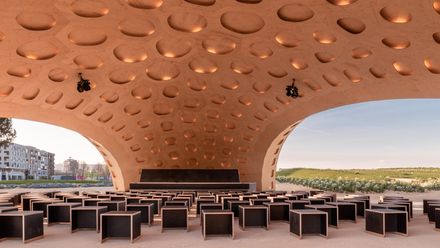
BUGA Wood Pavilion
ARCHITECTS
ICD/ITKE University of Stuttgart
PROOF ENGINEER
Prof. Dr.-Ing. Hugo Rieger
PHOTOGRAPHS
ICD-ITKE, Roland Halbe, BUGA
PROJECT YEAR
2019
LOCATION
Heilbronn, Germany
CATEGORY
Pavillion
Text description provided by architect.
The BUGA Wood Pavilion celebrates a new approach to digital timber construction.
Its segmented wood shell is based on biological principles found in the plate skeleton of sea urchins, which have been studied by the Institute for Computational Design, and Construction (ICD) and the Institute for Building Structures and Structural Design (ITKE) at the University of Stuttgart for almost a decade.
As part of the project, a robotic manufacturing platform was developed for the automated assembly and milling of the pavilion’s 376 bespoke hollow wood segments.
This fabrication process ensures that all segments fit together with sub-millimetre precision like a big, three-dimensional puzzle.
The stunning wooden roof spans 30 meters over one of BUGA’s main event and concert venues, using a minimum amount of material while also generating a unique architectural space.
The pavilion builds on the biomimetic principle of using “less material” by having “more form”, both on the level of the overall shell and its individual segments.
In order to minimize material consumption and weight, each wood segment is built up from two thin plates that plank a ring of edge-beams on top and bottom, forming large scale hollow wooden cases with polygonal forms.
The bottom plate includes a large opening, which constitutes a distinctive architectural feature and provides access to the hidden connections during assembly.
The lightweight building elements are connected by finger joints, which follow the morphological principles of anatomic features found on the edge of sea urchins’ plates. In the assembled state, the shell works as a form-active structure through its expressive doubly-curved geometry.





























